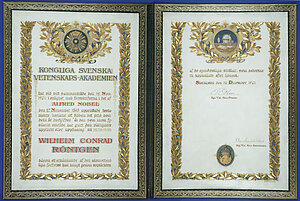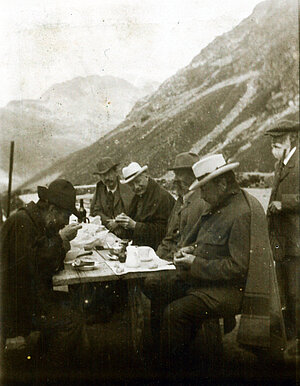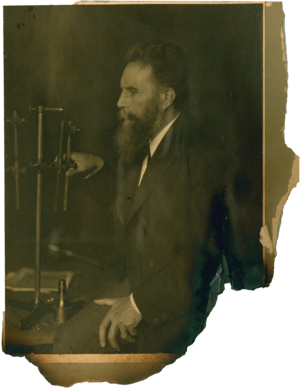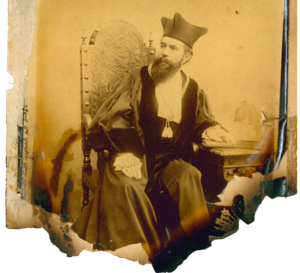Wilhelm Conrad Röntgen
* 27.03.1845 in Lennep, Remscheid † 10.02.1923 in Munich
1865 Study at the Federal Polytechnic Institute in Zurich
1868 Diploma as a mechanical engineer
1869 Promotion at the University of Zurich
1870 uncompensated Assistantship for August Kundt in Würzburg
1872 Transfer to the University of Strasburg
1874 cumulative postdoctoral lecture qualification in Strasburg
1875 Professorship at the Academy in Hohenheim
1876 extraordinary Professorship in Strasburg
1880 Professorship at the University of Giessen
1888 Professorship at the Julius-Maximilians-University of Würzburg
1895 Discovery of the “X-rays”
1900 Professorship at the University of Munich
1901 Nobel Prize in Physics
Wilhelm Conrad Röntgen can doubtlessly be considered as being one of the most important scholars of the Julius-Maximilians-University Würzburg. His discovery of the “X-Rays” brought him various honours and most importantly lead to his reception of the first ever awarded Nobel Prize in December 1901. The Universitsarchiv Würzburg therefore wants to use the Month December to honour Röntgen as the “Scholar of the Month”.
A rough start
The entry into the scientific career appeared to be rather difficult for Röntgen. After falsely being accused of a disciplinary offence, he had the leave the Technical School in Utrecht - which he attended from 1861 to 1863 - without being graduated. From 1865 on, he studied mechanical engineering at the Federal Polytechnic Institute in Zurich, which also accepted gifted students who did not receive their A-levels. There, he obtained his Diploma as a mechanical engineer in August 1868. In the following year he got his promotion to a Dr. phil., as he could submit a Dissertation at the University of Zurich without being matriculated. In 1870, Röntgen moved to Würzburg to work as an uncompensated assistant for August Kundt. But once again his missing A-levels put a strain on his scientific career, as the University of Würzburg would not accept his postdoctoral lecture qualification without it. When the young professor August Kundt changed to the Kaiser-Wilhelm-University in Strasburg, Röntgen followed him. There he could finally reach his cumulative postdoctoral lecture qualification. At the Academy in Hohenheim - where Röntgen transferred to in 1875 - he could gain his first experiences as a lecturer.
Röntgen in Würzburg
During his first stay in Würzburg from 1870 to 1872, Röntgen especially had to deal with the limited possibilities of technical interior and laboratory instruments of the time. Because of this limitation, Röntgen was able to develop certain practical skills to self-conceive his own experiments.
Röntgen himself said that he thinks that his accuracy didn’t suffer from the poor conditions of the laboratory instruments, which he developed himself in a simple way and almost entirely without the help of a mechanic. In 1888 Röntgen decided to return to Würzburg, to work as an ordinary professor for physics and as the head of the Institute of Physics, also because of the now more modern and bigger physical Laboratory in Würzburg. This second stay in Würzburg was doubtlessly of great importance for the research of Röntgen. In addition, he was also elected the Rector of the University in 1893.
A new kind of rays
Until his discovery of the X-rays, Röntgen researched among other things on the characteristics of quartzes and the compressibility of liquids. Already during his time in Giessen Röntgen could detect the magnetic force of a dielectric located between two electrically charged condensator plates, the so-called “Röntgenstrom”. In Würzburg he occupied himself with the examination of the electrical conduct of gasses with special consideration of cathode rays. At this juncture, Röntgen made the discovery of the X-rays on the 8th of November 1895 as he discovered an invisible ray that allowed him to see the inside of an organism. On the 28th of December of the same year, Röntgen published his new discovery with the title “A new kind of rays”. In January 1896 he also presented his findings at a public meeting of the physical-medical society in Würzburg. During this sitting there was also the first proposal of naming the rays after their discoverer. Röntgens work on the new kind of rays was decorated with the first ever Nobel Prize of the Royal Swedish Academy of Science on the 10. December 1901. At this time, Röntgen was already a professor in Munich.
Memory of Röntgen
Röntgen, who was known to be reclusive, didn’t hold a speech during the Nobel ceremony, donated the prize of 50.000 crowns to the University Würzburg and didn’t file a patent in order to make his discovery available for the broad masses. For his discovery, the well-respected experimental physician was awarded several honours and prizes, like the honour citizenship in Lennep and Würzburg or the “Verdienstorden der Bayerischen Krone”. But also streets and facilities where named after Röntgen, like the Röntgenring and the Röntgen-Gymnasium in Würzburg or the Röntgen Institute in Düsseldorf.
Recommended Readings
Mödder, Ulrich/ Schlug, Alexander: Die Augen des Professors. Wilhelm Conrad Röntgen; eine Kurzbiografie, Berlin 2008.
Leicht, Hans Dieter: Wilhelm Conrad Röntgen: Biografie, München 1994.
Röntgen, Wilhelm Conrad: Eine neue Art von Strahlen, Braunschweig 1995 (Faks. der Ausgabe Würzburg 1896).






